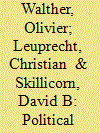| Srl | Item |
| 1 |
ID:
183003


|
|
|
|
|
| Summary/Abstract |
This article explores the spatial and temporal diffusion of political violence in North and West Africa by endeavoring to represent a group leader's mental landscape as he contemplates strategic targeting. We assume that this representation is a combination of the physical and social geography of the target environment, and the mental and physical cost of following a seemingly random pattern of attacks. Focusing on the distance and time between attacks and taking into consideration the transaction costs that state boundaries impose, we wish to understand what constrains a group leader to attack at a location other than the one that would yield the greatest overt payoff. We leverage functional data from the Armed Conflict Location and Event Data project (ACLED) dataset that catalogs violent extremist incidents in North and West Africa since 1997 to generate a network whose nodes are administrative regions. These nodes are connected by edges of qualitatively different types: undirected edges representing geographic distance, undirected edges incorporating the costs of crossing borders, and directed edges representing consecutive attacks by the same group. We analyze the resulting network using spectral embedding techniques that are able to account fully for the different types of edges. The result is a representation of North and West Africa that depicts its empirical permeability to violence. A better understanding of how location, time, and borders condition attacks enables planning, prepositioning, and response.
|
|
|
|
|
|
|
|
|
|
|
|
|
|
|
|
| 2 |
ID:
172175


|
|
|
|
|
| Summary/Abstract |
Drawing on a collection of open source data, the article uses network analysis to represent alliances and conflicts among 179 organizations involved in violence in North and Western Africa between 1997 and 2014. Owing to the fundamentally relational nature of internecine violence, this article investigates the way the structural positions of conflicting parties affect their ability to resort to political violence. To this end, we combine two spectral embedding techniques that have previously been considered separately: one for directed graphs that takes into account the direction of relationships between belligerents, and one for signed graphs that takes into consideration whether relationships between groups are positive or negative. We hypothesize that groups with similar allies and foes have similar patterns of aggression. In a region where alliances are fluid and actors often change sides, the propensity to use political violence corresponds to a group’s position in the social network.
|
|
|
|
|
|
|
|
|
|
|
|
|
|
|
|